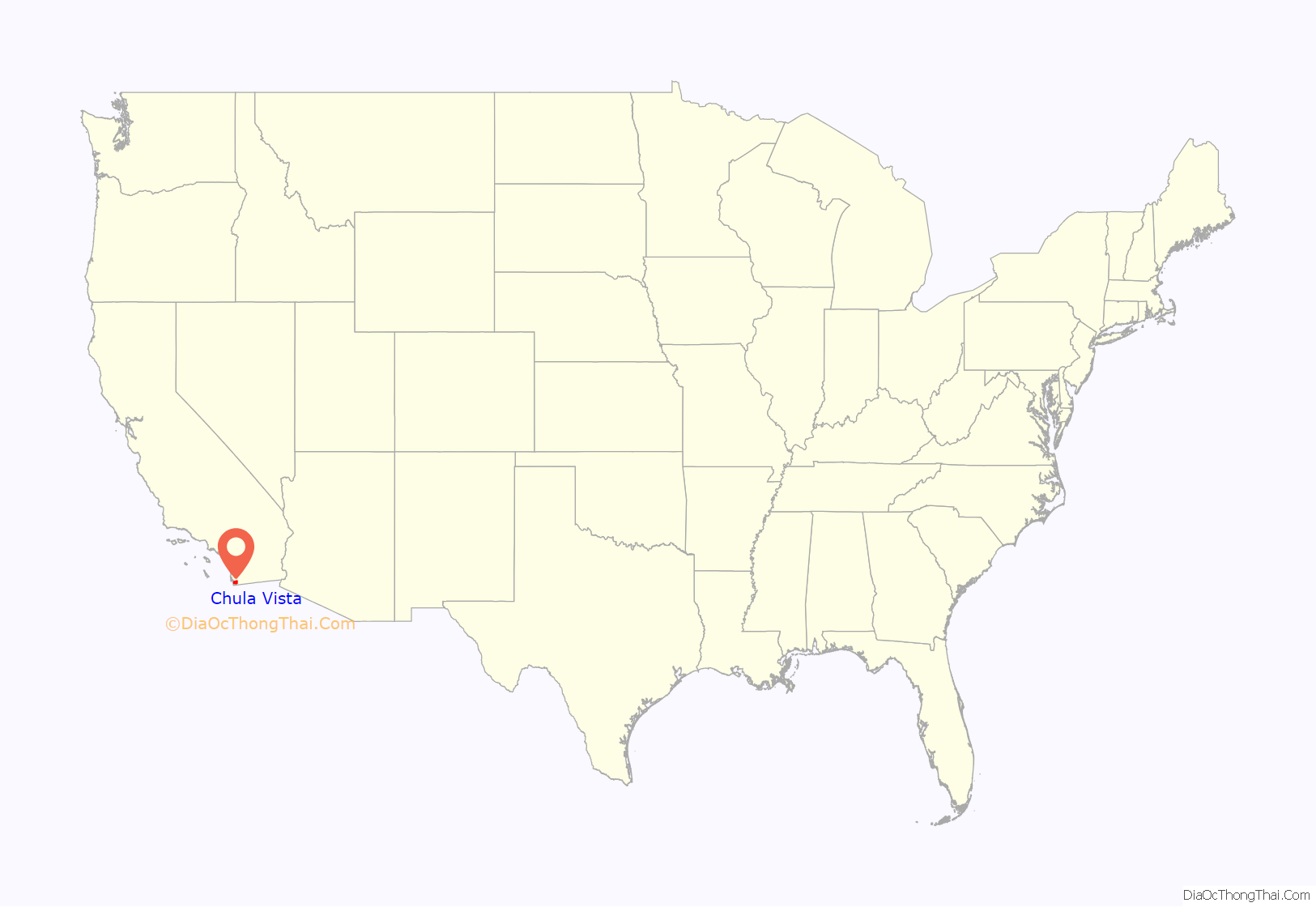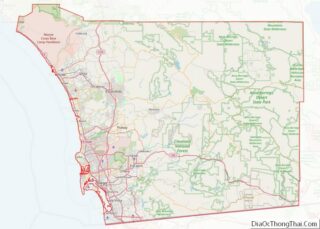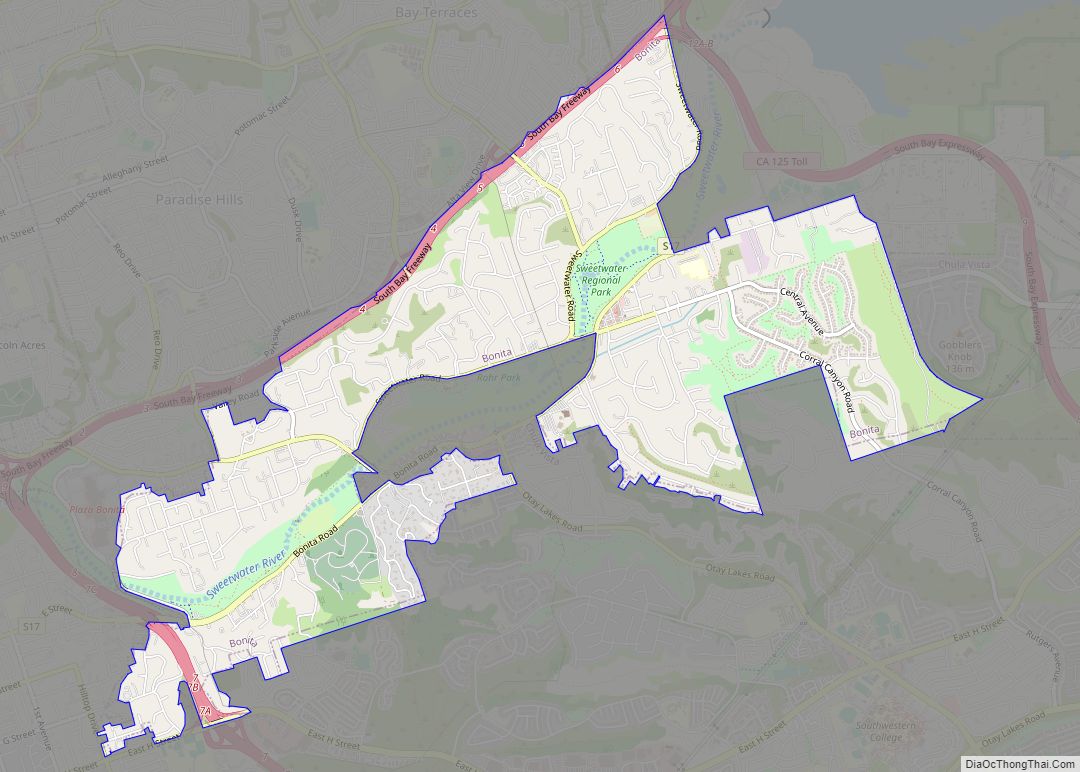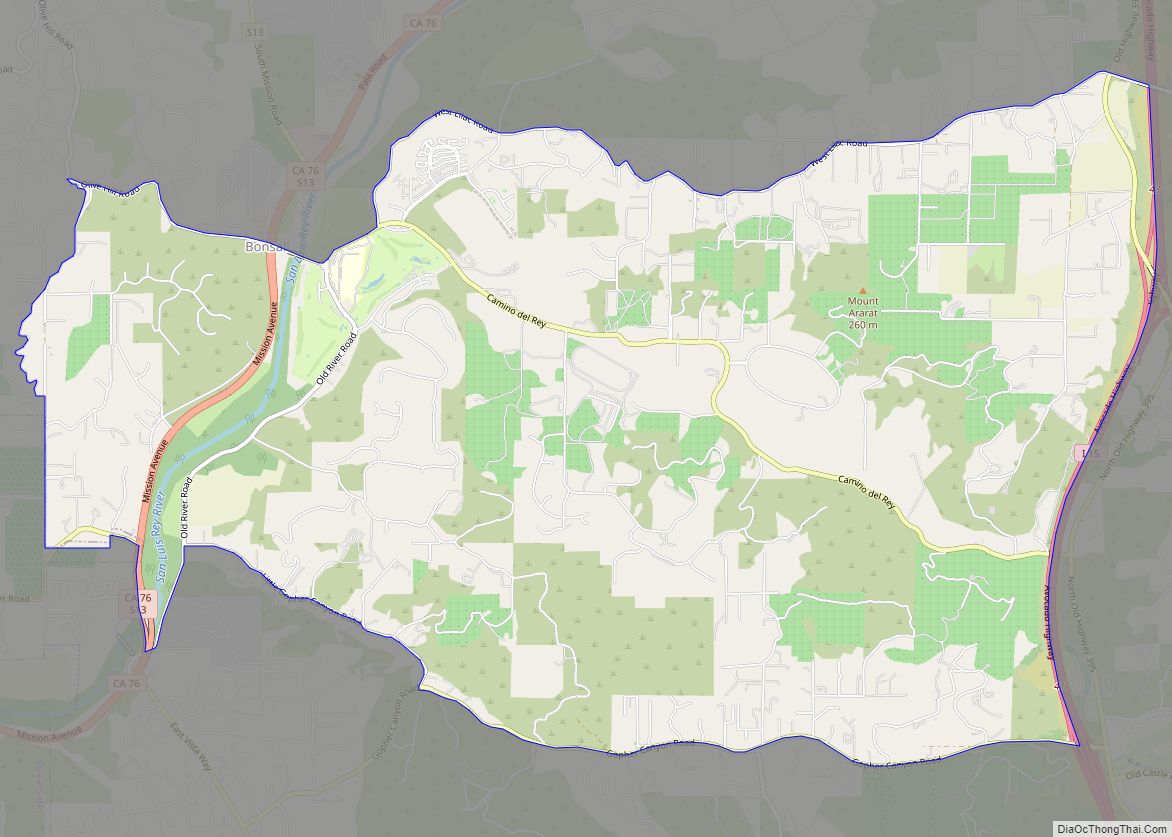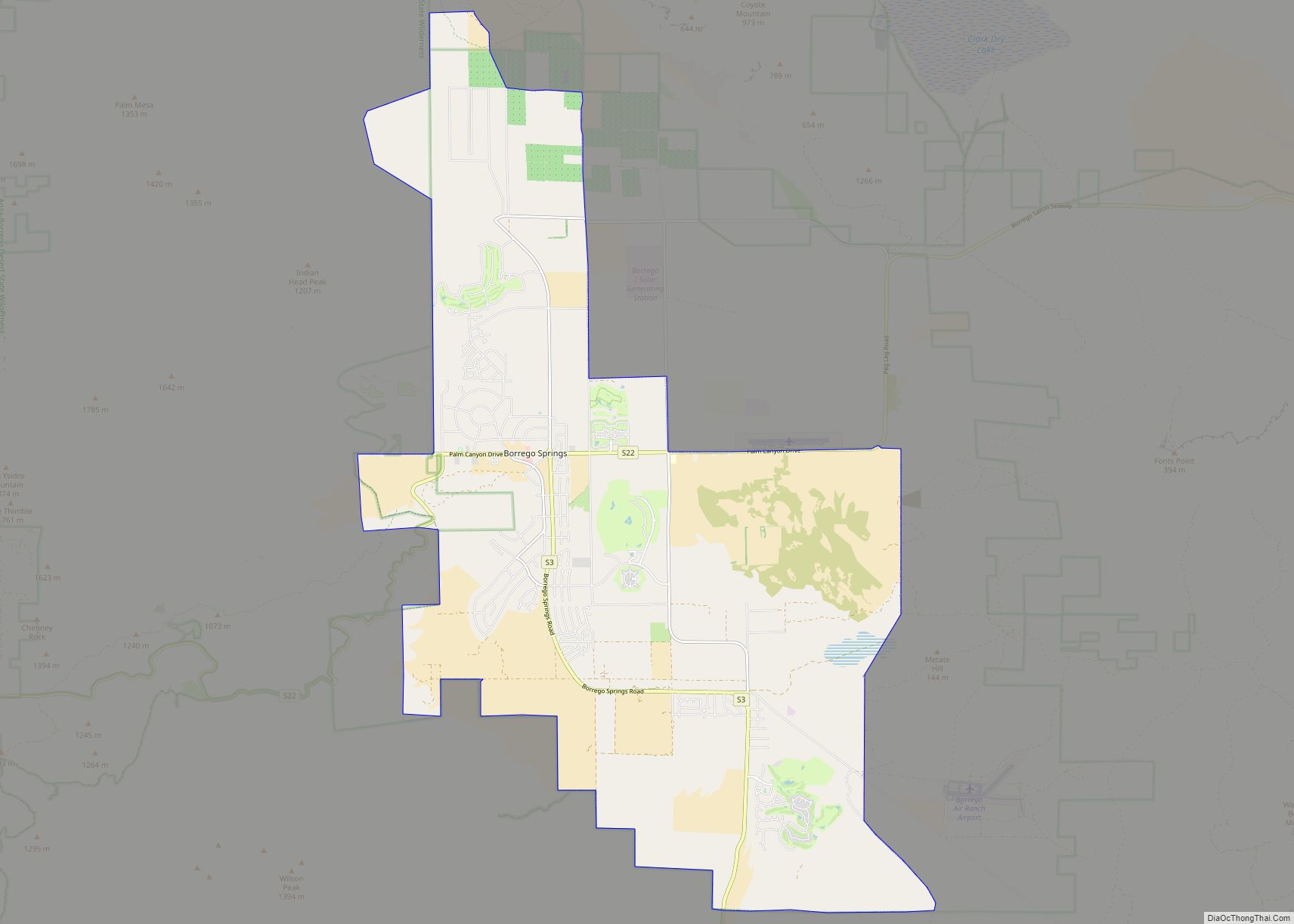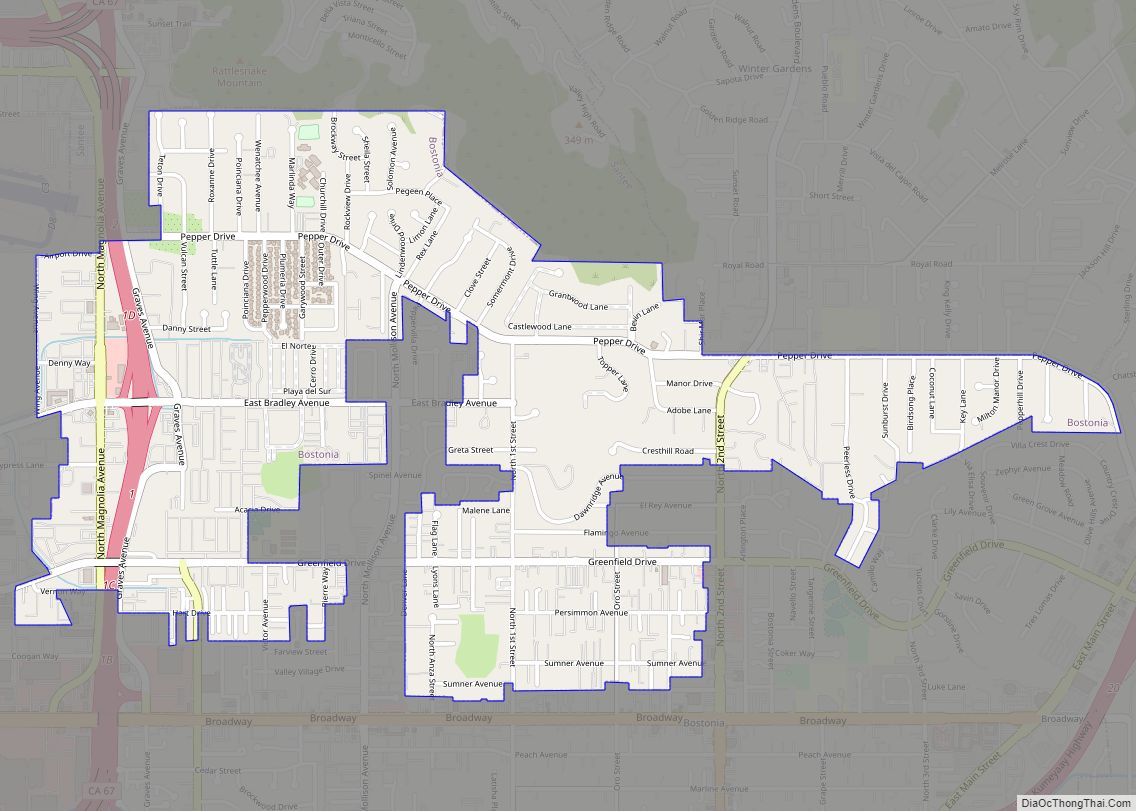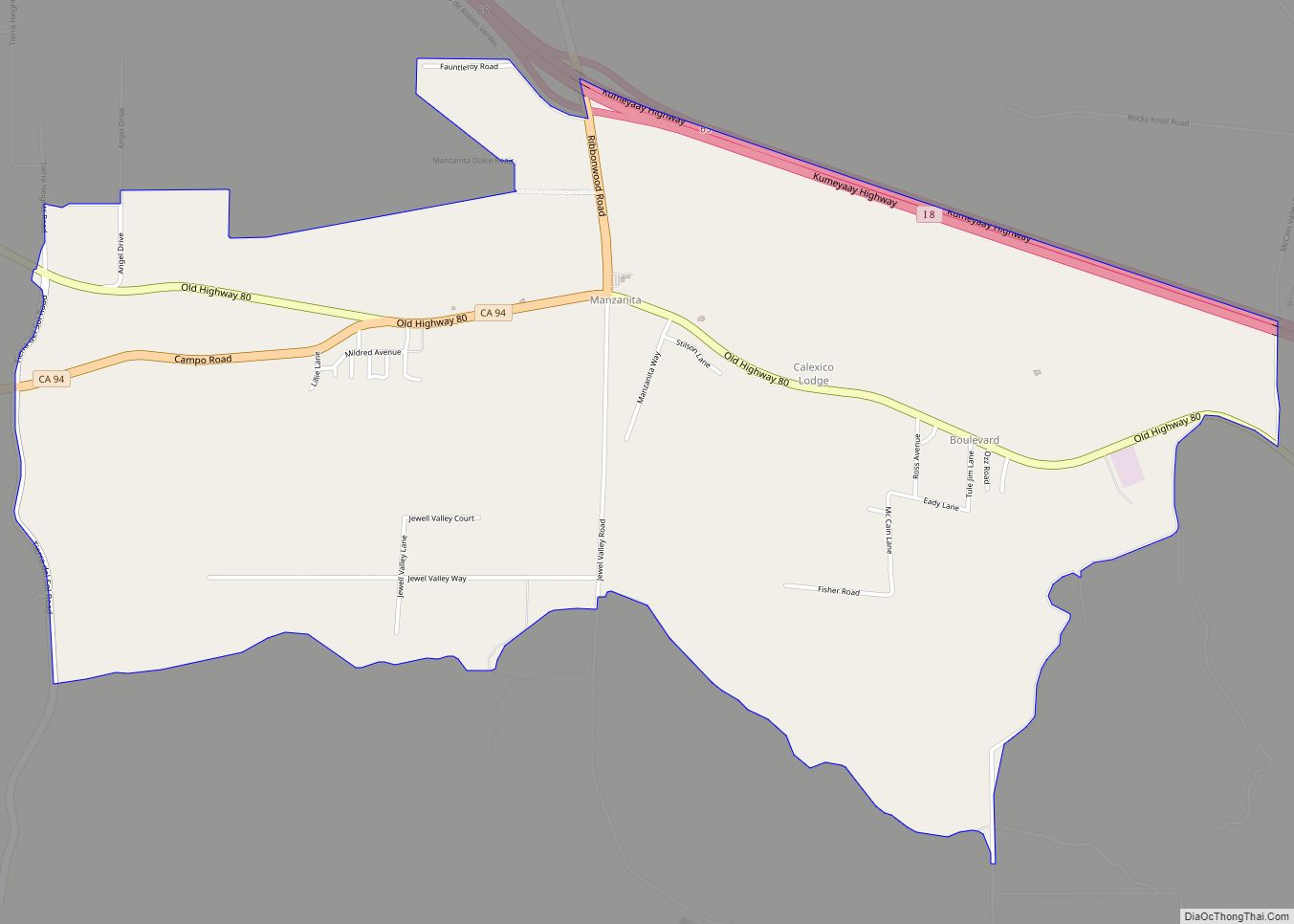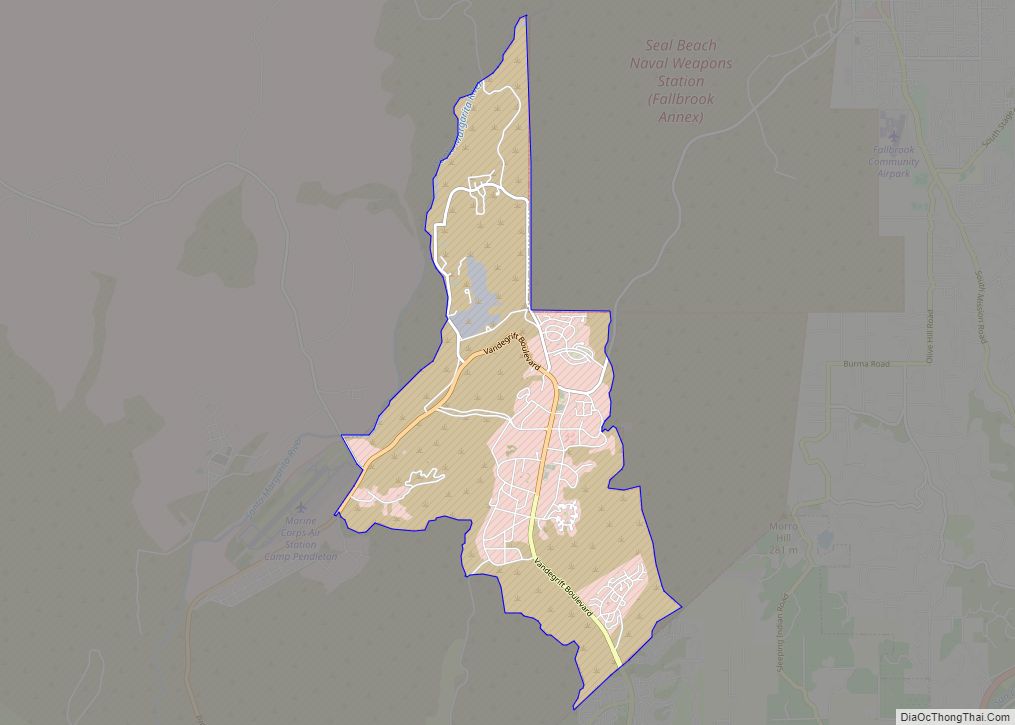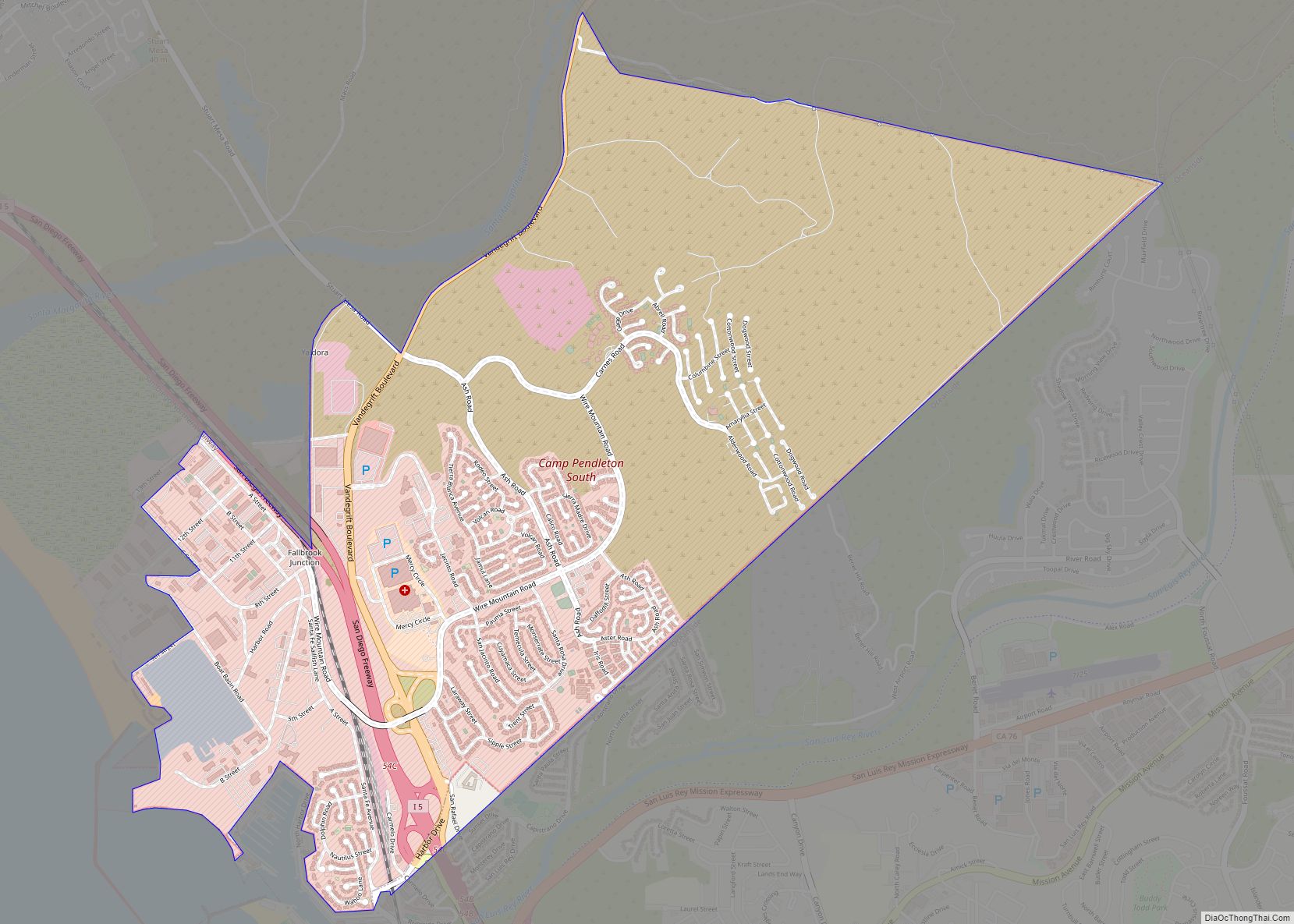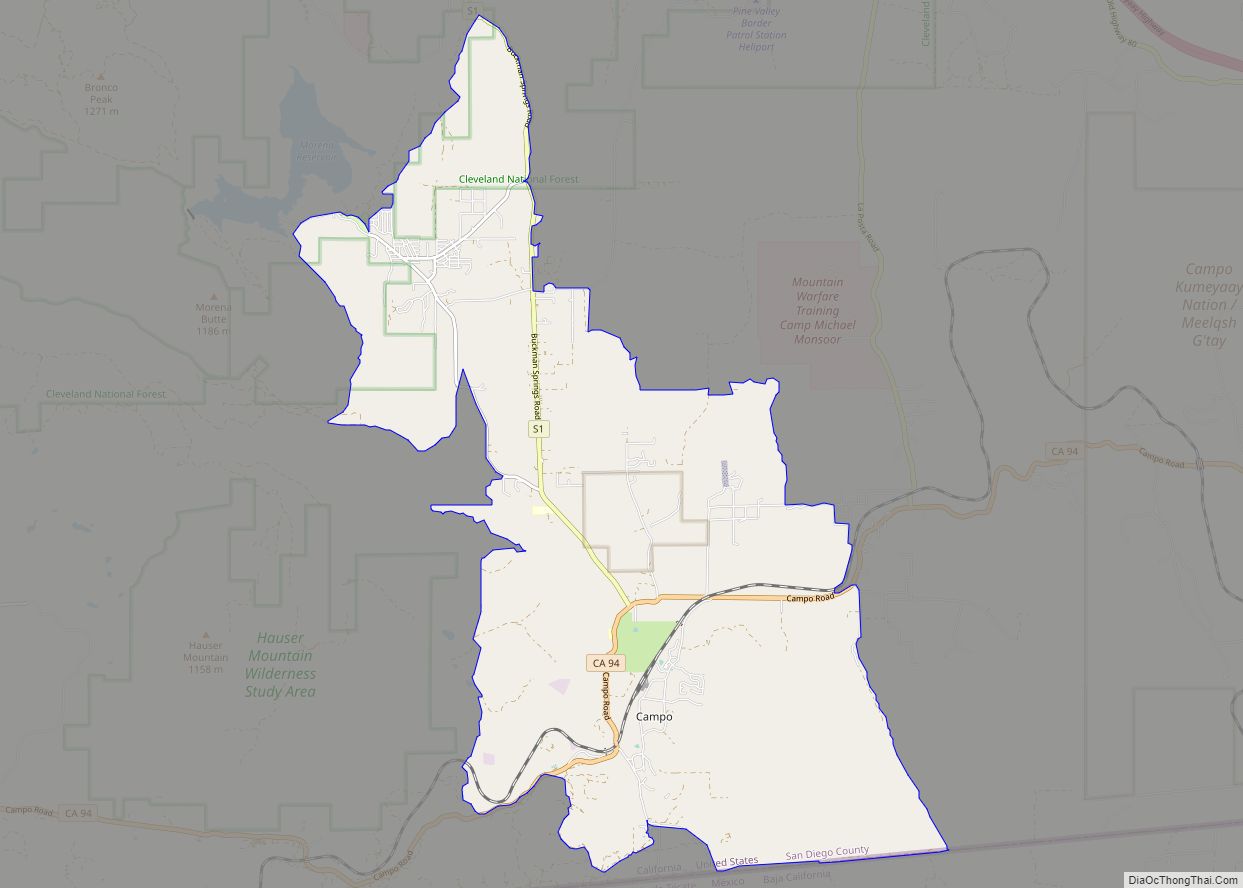Chula Vista (Spanish for ‘Beautiful View’; /ˌtʃuːlə ˈvɪstə/) is the second-largest city in the San Diego metropolitan area, the seventh largest city in Southern California, the fifteenth largest city in the state of California, and the 78th-largest city in the United States. The population was 275,487 as of the 2020 census, up from 243,916 as of the 2010 census. Located about halfway—7.5 miles (12.1 km)—between the two downtowns of San Diego and Tijuana in the South Bay, the city is at the center of one of the richest culturally diverse zones in the United States. Chula Vista is so named because of its scenic location between the San Diego Bay and coastal mountain foothills.
The area, along with San Diego, was inhabited by the Kumeyaay before contact from the Spanish, who later claimed the area. In 1821, Chula Vista became part of the newly declared Mexican Empire, which reformed as the First Mexican Republic two years later. California became part of the United States in 1848 as a result of the Mexican–American War and was admitted to the union as a state in 1850.
Founded in the early 19th century and incorporated in October 1911, fast population growth has recently been observed in the city. Located in the city is one of America’s few year-round United States Olympic Training centers, while popular tourist destinations include Sesame Place San Diego, North Island Credit Union Amphitheatre, the Chula Vista marina, and the Living Coast Discovery Center.
| Name: | Chula Vista city |
|---|---|
| LSAD Code: | 25 |
| LSAD Description: | city (suffix) |
| State: | California |
| County: | San Diego County |
| Incorporated: | November 28, 1911 |
| Elevation: | 66 ft (20 m) |
| Land Area: | 49.64 sq mi (128.56 km²) |
| Water Area: | 2.46 sq mi (6.36 km²) 4.73% |
| Population Density: | 5,549.70/sq mi (2,142.87/km²) |
| ZIP code: | 91909–91915, 91921 |
| Area code: | 619 |
| FIPS code: | 0613392 |
| Website: | www.chulavistaca.gov |
Online Interactive Map
Click on ![]() to view map in "full screen" mode.
to view map in "full screen" mode.
Chula Vista location map. Where is Chula Vista city?
History
Early history
Fossils of aquatic life, in the form of a belemnitida from the Jurassic, have been found within the modern borders of Chula Vista. It is not until the Oligocene epoch that land life fossils have been found; although Eocene epoch fossils have been found in nearby Bonita. It is not until 10,000 years ago that human activity has been found within the modern borders of Chula Vista, primarily in Otay Valley of the San Dieguito people. The oldest site of human settlement within the modern boundaries of Chula Vista, was named Otai by the Spanish in 1769, and had been occupied as far back as 7,980 years ago. Another place where humans first settled within the modern boundaries of Chula Vista was at the Rolling Hills Site, which dates back to 7,000 years ago.
In 3000 BCE, people speaking the Yuman (Quechan) language began moving into the region from the Lower Colorado River Valley and southwestern Arizona portions of the Sonoran desert. Later the Kumeyaay tribe came to populate the land, on which the city sits today, and lived in the area for hundreds of years. The Kumeyaay built a village known as Chiap (or Chyap) which was located by mudflats at the southern end of South Bay.
In 1542 CE, a fleet of three Spanish Empire ships commanded by Juan Rodríguez Cabrillo, sailed into San Diego Harbor. Early explorations by Spanish conquistadors, such as these, led to Spanish claims of the land. The village of Chiap (known to the Spanish as La Punta) became a center of a Kumeyaay revolt against the Spanish in 1775, which was later abandoned by 1776. The historic land on which Chula Vista sits became part of the 1795 land grant known as Rancho del Rey or The King’s Ranch. The land eventually was renamed Rancho de la Nación.
After Mexico became independent from Spain, what is now Chula Vista became part of Alta California. Beginning in 1829, the land that is now Chula Vista was divided among Rancho Janal, Rancho Otay, Rancho de la Nación and Rancho La Punta; these were owned by José María Estudillo, José’s sister Maria, John (Don Juan) Forster, and Santiago E. Argüello respectively.
During the Mexican–American War, California was claimed by the United States, regardless of the California independence movement that had briefly swept the state. Though California was now under the jurisdiction of the United States, land grants were allowed to continue in the form of private property. In 1873, the United States Army built a telegraph line between San Diego and Fort Yuma which ran through Telegraph Canyon in Chula Vista; its construction was under the command of Captain George F. Price of the 5th Cavalry Regiment out of Camp McDowell. In the 1870s and 1880s mining was done on Rancho Janal.
The San Diego Land and Town Company developed lands of the Rancho de la Nación for new settlement. The town began as a five thousand acre development, with the first house being erected in 1887; by 1889, ten houses had been completed. Around this time, the lemon was introduced to the city, by a retired professor from the University of Wisconsin. Chula Vista can be roughly translated from Spanish as “beautiful view”; the name was suggested by Sweetwater Dam designer James D. Schulyer.
The 1888 completion of the dam allowed for irrigation of Chula Vista farming lands. Chula Vista eventually became the largest lemon-growing center in the world for a period of time. As of February 2019, the oldest surviving buildings in Chula Vista originate from around this time, including the Barber house, and the Cordrey house. Additionally, the Coronado Belt Line Railroad was built through Chula Vista, connecting Hotel Del Coronado with the National City, where Southern California Railroad terminated. Another railroad built through Chula Vista, was the National City and Otay Railroad, which was routed down Third Avenue. During the depression at the end of the century, industrial employment in Chula Vista was limited to the La Punta Salt Works and packing houses.
20th century
The citizens of Chula Vista voted to incorporate on October 17, 1911. The State approved the city’s incorporation in November. One of its first city council members was a former Clevelandite Greg Rogers, who was also a leader of the Chula Vista Yacht Club. The yacht club would the first on the West Coast to build race specific boats, which resulted in a uniquely designed sloop. In 1915, a Carnegie Library was built on F Street. In the 1910s, Chinese, Filipino, and Mexican farm laborers worked the fields within the city, with most commuting in from Downtown San Diego and Logan Heights.
In January 1916, Chula Vista was impacted by the Hatfield Flood, which was named after Charles Hatfield, when the Lower Otay Dam collapsed flooding the valley surrounding the Otay River; up to fifty people died in the flood. Later in 1916, the Hercules Powder Company opened a 30-acre bayfront site, now known as Gunpowder point, which produced substances used to make cordite, a gun propellant used extensively by the British Armed Forces during World War I. In 1920, the San Diego Country Club opened in Chula Vista, with its clubhouse designed by Richard Requa who had previously worked on the California Pacific International Exposition. In 1925, aviation began in Chula Vista, with the Tyce School of Aviation, operating the Chula Vista Airport. In 1926, the salt works purchased Rancho Janal and grew barley and lima beans.
Although the Great Depression affected Chula Vista significantly, agriculture still provided considerable income for the residents. In 1931, the lemon orchards produced $1 million in revenue and the celery fields contributed $600,000. Japanese American farms played a significant role in developing new crops outside of lemons, especially celery. In the 1930s, led by Chris Mensalvas, Filipino and Mexican farm workers went on strike against the celery farms. To the east, on land formerly known as Rancho Janal, dairy farming and cattle farming was done on over 4,000 acres (1,600 ha). By the end of the 1930s, the city’s population of over 4,000 residents was mostly Caucasian, with small populations of Japanese and Mexican Americans. Prior to World War II, anti-Japanese sentiment had existed in Chula Vista, due to competition between Japanese farmers and White farmers, however an association was formed which decreased those sentiments.
In November 1940, the city purchased the Chula Vista Airport for Rohr Aircraft. The relocation of Rohr Aircraft Corporation to Chula Vista in early 1941, just months before the attack on Pearl Harbor, changed Chula Vista. The land never returned to being orchard groves again. At the Rohr factory, the 11,000 employees worked on power units for the Consolidated B-24 Liberator. In 1945, The Vogue Theater opened.
Due to Executive Order 9066, the Japanese Americans who lived in Chula Vista were sent to Santa Anita Racetrack and then to the Poston War Relocation Center. One of those Japanese Americans from Chula Vista was Joseph K. Sano, who was an air corps veteran of World War I, and a member of the American Legion; during World War II, Sano served in the Military Intelligence Service Language School at the University of Michigan. In 1944, the state of California attempted to seize land in Chula Vista owned by Kajiro Oyama, a legal Japanese resident who was then interned in Utah. Oyama was correctly charged with putting the property in his son Fred’s name with the intent to evade the Alien Land Law because Fred was a native-born citizen. The case went to the U.S. Supreme Court as Oyama v. California, where the court found that Kajiro’s equal protection rights had been violated.
The population of post–World War II Chula Vista tripled from 5,000 residents in 1940 to more than 16,000 in 1950. After the war, many of the factory workers and thousands of servicemen stayed in the area, resulting in the huge growth in population. The last of the citrus groves and produce fields disappeared as Chula Vista became one of the largest communities in San Diego County. In 1949, the city limits of Chula Vista expanded for the first time. Due to the construction of the Montgomery Freeway, the Arguello Adobe of Rancho La Punta was demolished. In 1955, the Big Ski Drive-In opened; until it closed in 1980, it was one of the largest drive-in theaters in the nation. By the 1960s, Chula Vista continued its expansion with the annexation of part of Bonita. That same decade, Filipinos and Mexicans began to move into Chula Vista in significant numbers; these included Filipino navy veterans. In 1963, Chula Vista became the second-largest city in San Diego County. From 1960 to 2013, the South Bay Power Plant, a 700-megawatt, four-boiler plant, occupied 115 acres (47 ha) of the Chula Vista waterfront.
In 1985, Chula Vista made the largest annexation in California history, which included the neighborhoods of Castle Park and Otay. In January 1986, Chula Vista annexed the unincorporated community of Montgomery, which had previously rejected annexation in 1979 and 1982. At the time of the annexation the community was virtually surrounded by its larger neighbor. Later, San Diego gave way, allowing Chula Vista to annex the Otay River Valley, which was opposed by residents in Otay Mesa and Nestor. Over the next few decades, Chula Vista continued to expand eastward. Plans called for a variety of housing developments such as the Eastlake, Rancho del Rey, and Otay Ranch neighborhoods. During this expansion a walrus fossil was found, of an extinct species of toothless Valenictus, after the species was named for the city. The quick expansion east of Interstate 805 was not embraced by all of the cities residents, leading to advocacy that new housing developments be built with parks, schools, and emergency services. In 1991, Chula Vista elected its first female mayor, Gayle McCandliss, who died from cancer a few weeks after being elected. In 1995, the United States Olympic Committee opened an Olympic Training Center in Eastlake on donated land; it is the USOC’s first master-planned facility and is adjacent to Lower Otay Reservoir. In the last decade of the century, a desalinization plant opened to process water from wells along the Sweetwater River; it was expanded less than two decades later, which included a pumping station built in Bonita.
During World War I and II, the army maintained a base on the present-day corner of Main Street and Albany Avenue. It initially served as a border post during World War I, and was reestablished in December 1942. It was home to the 140th Infantry Regiment, 35th Infantry Division. The regiment conducted war games against the Camp Lockett–based 10th Cavalry, and were defeated. The base was closed in February 1944, and the division went on to see combat in the European theater. All traces of the post have since been removed.
21st century
In 2003, Chula Vista had 200,000 residents and was the second-largest city in San Diego County. That year, Chula Vista was the seventh fastest growing city in the nation, growing at a rate of 5.5%, due to the communities of Eastlake and Otay Ranch. Chula Vista is growing at a fast pace, with major developments taking place in the Otay Valley near the U.S. Olympic Training Center and Otay Lake Reservoir. Thousands of new homes have been built in the Otay Ranch, Lomas Verdes, Rancho Del Rey, Eastlake and Otay Mesa areas. In mid-2006, officials from Chula Vista and the San Diego Chargers met to discuss the potential construction of a new stadium that would serve as the home for the team; however, in June 2009, the Chargers removed Chula Vista as a possible location for a new stadium. The South Bay Expressway, a toll-road extension of State Route 125, opened on November 19, 2007.
As a result of the Mexican Drug War, many Mexicans from Tijuana began to immigrate to Chula Vista. Being in close proximity to Tijuana, however, has led to some drug war activity within Chula Vista. Yet in 2009, Chula Vista—along with nine other second-tier metropolitan area cities such as Hialeah, Florida, and California’s own Santa Ana—was ranked as one of the most boring cities in America by Forbes magazine, citing the large population but rare mentions of the city in national media.
In 2013, Forbes called Chula Vista the second-fastest-growing city in the nation, having recovered from the slowdown during the Great Recession, which saw the city lead the nation in having the highest mortgage default rate. In 2014, a survey conducted at the request of the city found that the majority of San Diegans surveyed had a negative perception of the city. By 2015, there were over 31,000 Filipino Americans living in Chula Vista; they make up the majority of the 48,840 Asian Americans who live in Chula Vista. In 2017, Chula Vista purchased the Olympic Training Center and renamed it to Elite Athlete Training Center; the United States Olympic Committee plans to continue to use the facility and pay rent to the city. That same year, a post office in the Eastlake neighborhood was renamed Jonathan “J.D.” De Guzman Post Office Building, in honor of a city resident who died while a San Diego Police Department officer in 2016; having immigrated from the Philippines in 2000, De Guzman was active in his community in Chula Vista, and went on to serve as a police officer for 16 years until his death.
The number of reported calls to the Chula Vista Police about issues regarding homeless individuals have increased from 2004 to 2014, with Chula Vista having the largest population of homeless individuals in the South Bay. In 2016, it was estimated that there were about 500 homeless individuals in Chula Vista. Due to the increase in homeless population, Chula Vista, and other neighboring cities began to pass ordinances on recreational vehicles, and other large vehicles, resulting in the number of homeless individuals within the city. By 2018, the number of homeless individuals in Chula Vista was down to 367.
In 2018, a proposal was made to develop Rohr Park into something similar to Griffith Park in Los Angeles. A development plan is to develop the bayfront.
In 2019, Chula Vista was the first city in California to be certified as a sanctuary city by the national non-profit “Welcoming America.” In December 2022, the “Welcoming City” designation was revoked due to concerns about its surveillance program. The Chula Vista Police Department was sharing license plate reader data with ICE and CBP.
Chula Vista Road Map
Chula Vista city Satellite Map
Geography
Owning up to its Spanish name origins – beautiful view – Chula Vista is located in the South Bay region of San Diego County, between the foothills of the Jamul and San Ysidro Mountains (including Lower Otay Reservoir) and San Diego Bay on its east and west extremes, and the Sweetwater River and Otay River at its north and south extremes. The geography of Chula Vista is impacted by the La Nacion and Rose Canyon Fault zones; it has moved rocks from Pleistocene and younger eras. Yet, as late as 13,000 years ago, soils in the Rancho del Rey area have been unaffected by fault activity.
Chula Vista is the second largest city, by area, within San Diego County. According to the United States Census Bureau, the city covers an area of 52.1 square miles (135 km), 49.6 square miles (128 km) of it land, and 2.5 square miles (6.5 km) or 4.73% of it water.
Ecological preserves
Chula Vista has within its city limits the Sweetwater Marsh unit of the San Diego Bay NWR. It also maintains several city maintained open space areas.
Neighborhoods
The original Chula Vista encompasses the area west of Hilltop Drive and north of L Street. The community of Montgomery was annexed by the city, after several failed attempts, in 1986; The community consists of most of the area south of L Street, west of Hilltop Drive and north of San Diego’s city limit. Unlike East Chula Vista, West Chula Vista does not have Mello-Roos, which has been suggested to have led to those not living in West Chula Vista to develop a separate civic identity.
Beginning in the late 1980s the planned communities of Eastlake, Otay Ranch, Millenia, and Rancho del Rey began to develop in the annexed areas east of Interstate 805 and California State Route 125. These communities expanded upon the eastern annexations of the 1970s, including the area around Southwestern College. In 1986, Eastlake began to be built. In 1989, Rancho del Rey was established. In 1999, Otay Ranch began to be built on 23,000 acres.
In the years around 2008 thousands of Tijuana’s elite bought houses in and moved to Eastern Chula Vista escaping violence, kidnapping and other crime taking place during that period in the Mexican metropolis only a few miles away. The Los Angeles Times wrote, “So many upper-class Mexican families live in…Eastlake…and Bonita…that…the area is becoming a gilded colony of Mexicans, where speaking English is optional and people can breathe easy cruising around in their Mercedes-Benzes and BMWs.” In late 2018, a new Rapid bus route was created, taking passengers from the Otay Mesa Port of Entry, through Eastern Chula Vista, and then into Downtown San Diego.
Climate
Like the rest of lowland San Diego County, Chula Vista has a semi-arid climate (BSk), with mediterranean characteristics, though the winter rainfall is too low and erratic to qualify as an actual Mediterranean climate.
With a moderate climate where the annual averages seldom oscillate much, there has still been a 103 °F (39 °C) high and a 24 °F (−4 °C) low recorded since the station’s inception in 1918. In 1949, the maximum daytime temperature was just 44 °F (7 °C) once, the lowest on record. Thanks to the maritime moderation, on average the coldest day is at a very mild 57 °F (14 °C). Summer nights are warmer than in coastal climates further north, but cooler than in the hot interior. The warmest low on record is 78 °F (26 °C) in 2016, while the warmest average night between 1991 and 2020 stood at 72 °F (22 °C).
See also
Map of California State and its subdivision:- Alameda
- Alpine
- Amador
- Butte
- Calaveras
- Colusa
- Contra Costa
- Del Norte
- El Dorado
- Fresno
- Glenn
- Humboldt
- Imperial
- Inyo
- Kern
- Kings
- Lake
- Lassen
- Los Angeles
- Madera
- Marin
- Mariposa
- Mendocino
- Merced
- Modoc
- Mono
- Monterey
- Napa
- Nevada
- Orange
- Placer
- Plumas
- Riverside
- Sacramento
- San Benito
- San Bernardino
- San Diego
- San Francisco
- San Joaquin
- San Luis Obispo
- San Mateo
- Santa Barbara
- Santa Clara
- Santa Cruz
- Shasta
- Sierra
- Siskiyou
- Solano
- Sonoma
- Stanislaus
- Sutter
- Tehama
- Trinity
- Tulare
- Tuolumne
- Ventura
- Yolo
- Yuba
- Alabama
- Alaska
- Arizona
- Arkansas
- California
- Colorado
- Connecticut
- Delaware
- District of Columbia
- Florida
- Georgia
- Hawaii
- Idaho
- Illinois
- Indiana
- Iowa
- Kansas
- Kentucky
- Louisiana
- Maine
- Maryland
- Massachusetts
- Michigan
- Minnesota
- Mississippi
- Missouri
- Montana
- Nebraska
- Nevada
- New Hampshire
- New Jersey
- New Mexico
- New York
- North Carolina
- North Dakota
- Ohio
- Oklahoma
- Oregon
- Pennsylvania
- Rhode Island
- South Carolina
- South Dakota
- Tennessee
- Texas
- Utah
- Vermont
- Virginia
- Washington
- West Virginia
- Wisconsin
- Wyoming
